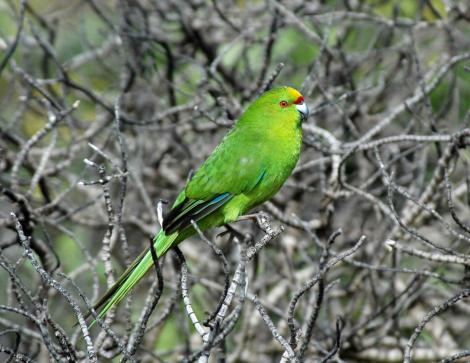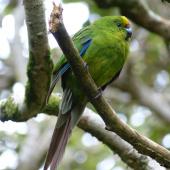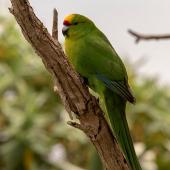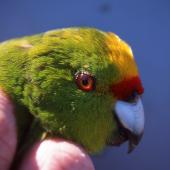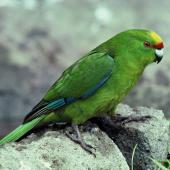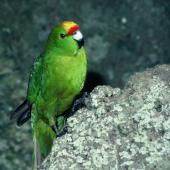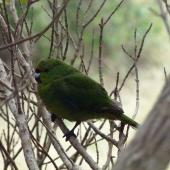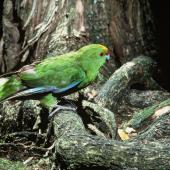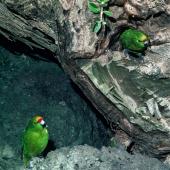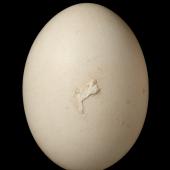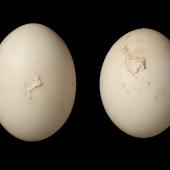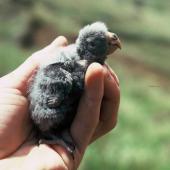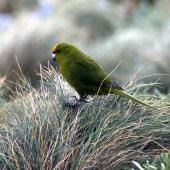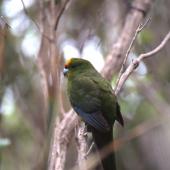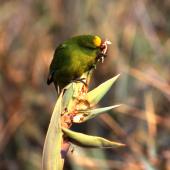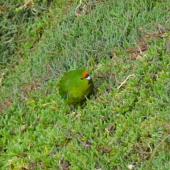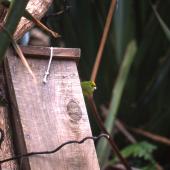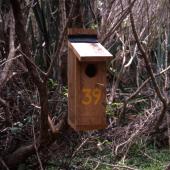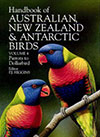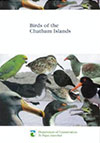Forbes' parakeet
Cyanoramphus forbesi Rothschild, 1893
Order: Psittaciformes
Family: Psittaculidae
New Zealand status: Endemic
Conservation status: Nationally Endangered
Other names: Chatham Island yellow-crowned parakeet, Forbes parakeet, Forbe's parakeet, Forbes's parakeet
Geographical variation: Previously considered a subspecies of yellow-crowned parakeet. Genetic comparisons revealed that Forbes’ parakeets are derived from ancestral stock, and are equally close (or distant) to both red-crowned and yellow-crowned parakeets.
Forbes’ parakeets are one of two bright green, medium-sized parrots of the Chatham Islands. Although they appear very similar to the yellow-crowned parakeet of mainland New Zealand, crown colour is not a reliable indicator of taxonomic relationships. Forbes’ parakeets are believed to be descended from an ancient parakeet lineage that reached the Chatham Islands before the red-crowned/yellow-crowned split occurred on mainland New Zealand, after which red-crowned parakeets subsequently colonised the Chatham Islands also. Formerly found throughout the Chatham Islands, Forbes’ parakeets are now restricted to Mangere and Little Mangere Islands. Here, they are abundant, but were threatened through large-scale hybridisation with Chatham Island red-crowned parakeets. Hybrids currently comprise less than 10% of the Mangere Island parakeet population, and this proportion is closely monitored by the Department of Conservation.
Identification
Forbes’ parakeets are medium-sized, long-tailed parrots with broad, rounded wings and predominantly emerald green plumage. They have a bright yellow fore-crown and a crimson frontal band that does not extend to the eye (cf. red-crowned parakeet). Males are larger than females.
Voice: characteristic chatter, with variety of softer tur-tur-tur calls; similar to other Cyanoramphus parakeet species.
Similar species: Forbes’ parakeets have similar plumage to the smaller yellow-crowned parakeet, which does not occur on the Chatham Islands. Crown colouration is the only reliable diagnostic feature distinguishing Forbes’ parakeets (bright yellow) and Chatham Island red-crowned parakeets (red). Forbes’ parakeet is the predominant species on Mangere Island, with red-crowned parakeets comprising less than 5% of the population. Hybrid birds exhibit a continuum of crown colouration between the two species. Careful visual inspection of crown and head colouration is required to separate hybrid birds from Forbes’ parakeets, with assessment of whether the red frontal band extends to the eye (hybrid) or not (Forbes’) considered a diagnostic character.
Distribution and habitat
Forbes’ parakeets are presumed to have occurred throughout forested areas of Chatham Islands, but there is no recognised method to distinguish Forbes’ and red-crowned parakeet bones, which is needed to confirm their original distributions. By the time naturalists began visiting the Chatham Islands in the 1840s to 1890s, Forbes’ parakeets were confined to Pitt, Mangere and Little Mangere Islands. They disappeared from Pitt and Mangere Islands about 1890 following forest destruction and introduction of cats to both islands. Fortunately they survived on 10 ha Little Mangere Island, and recolonised the adjacent 131 ha Mangere Island after cats and sheep were eradicated from the larger island. They are currently restricted to densely vegetated areas of Mangere Island and Little Mangere Island although vagrants have appeared occasionally on Pitt and Chatham Islands. Improving habitat quality and quantity and the management of hybridisation have resulted in a significant population increase. Potential sites for translocation to Chatham Island are being considered.
Population
Forbes’ parakeets are common on Mangere Island, where the parakeet population is estimated at 1,000 birds. Forbes’ parakeets comprise in excess of 90% of this total, with the remainder being Chatham Island red-crowned parakeets and hybrids. Forbes’ parakeets are also present on Little Mangere Island, with birds regularly commuting between the two islands.
Threats and conservation
Forbes’ parakeets were historically threatened by extensive habitat modification and predation by feral cats. They were reduced to extremely low numbers by the 1970s (< 75 birds). More recently, Forbes’ parakeets have hybridised with Chatham Island red-crowned parakeets, jeopardising the genetic integrity of the species. Recent conservation initiatives such as extensive reforestation, provision of nest boxes and management of Chatham Island red-crowned parakeets and hybrids on Mangere Island has resulted in significant improvements in both habitat quality and parakeet numbers. Forbes’ parakeets are now common on most parts of Mangere Island, and there are plans for their introduction into pest-free habitats on Chatham Island.
Breeding
Forbes’ parakeets have an extended breeding season, with eggs laid between October and March. They are cavity-nesters, preferring hollows in trees but also using rock crevices and under dense vegetation. The average clutch size is 5 eggs. Like all other Cyanoramphus parakeets, females are responsible for nest preparation, incubation, brooding and feeding of chicks until 10-14 days of age. During this period all her food is provided by her mate. Thereafter, male and female parakeets feed chicks at the nest until they fledge.
Incubation usually commences after the second egg is laid, resulting in chicks within a brood varying greatly in age and size. The last chicks to hatch out usually fledge at an earlier age and are less developed than their older siblings. More than one brood may be attempted if the initial nest fails or if food supply allows.
Behaviour and ecology
Forbes’ parakeets occur at higher densities in forest and in areas of dense regenerating vegetation than in open grassland. Despite their rather erratic flight they are strong fliers and readily move between Mangere and Little Mangere Islands. Individual Forbes’ parakeets have occasionally been observed in the southern forests of Chatham Island (>20 km from Mangere Island) and on nearby Pitt and Rangatira Islands. Their social behaviour is similar to other species of Cyanoramphus parakeets. They are strongly territorial around nests, calling loudly and chasing intruders from vicinity.
Food
Food items consumed by Forbes’ parakeets are affected by seasonal availability, and include seeds, flowers and leaves from a variety of plants, with invertebrates more important in spring. They forage extensively on the ground in more open areas.
Weblink
References
Aikman, H.; Miskelly, C. 2004. Birds of the Chatham Islands. Department of Conservation, Wellington.
Fleming, C.A. 1939. Birds of the Chatham Islands. Emu 38: 380-413.
Greene, T.C. 1989. Forbes’ parakeet on Chatham Island. Notornis 36: 326-327.
Higgins, P.J. (Ed.) 1999. Handbook of Australian, New Zealand and Antarctic birds. Vol. 4, parrots to dollarbird. Oxford University Press, Melbourne.
Nixon, A.J. 1994. Feeding ecology of hybridizing parakeets on Mangere Island, Chatham Islands. Notornis 41: 5-18.
Taylor, R.H. 1975. Some ideas on speciation in New Zealand parakeets. Notornis 22: 110-121.
Taylor, R.H. 1985. Status, habits and conservation of Cyanoramphus parakeets in the New Zealand region. ICBP Tech. Publ. 3: 195-211.
Recommended citation
Greene, T.C. 2013 [updated 2022]. Forbes’ parakeet. In Miskelly, C.M. (ed.) New Zealand Birds Online. www.nzbirdsonline.org.nz
Forbes' parakeet
- Social structure
- monogamous
- Breeding season
-
- Jul
- Aug
- Sep
- Oct
- Nov
- Dec
- Jan
- Feb
- Mar
- Apr
- May
- Jun
- Nest type
- tree hole
- Nest description
- Natural cavities, usually within trunk or large limb of tree but will use cavities on ground, within thick vegetation.
- Nest height (mean)
- 0.8 m
- Maximum number of successful broods
- 1
- Clutch size (mean)
- 5.3
- Clutch size (min)
- 1
- Clutch size (max)
- 10
- Mean egg dimensions (length)
- 23.4 mm
- Mean egg dimensions (width)
- 19.1 mm
- Egg colour
- Lustreless white
- Egg laying dates
-
- Jul
- Aug
- Sep
- Oct
- Nov
- Dec
- Jan
- Feb
- Mar
- Apr
- May
- Jun
- Interval between eggs in a clutch
- 1-3 days days
- Incubation behaviour
- female only
- Incubation length (mean)
- 22 days
- Incubation length (min)
- 20 days
- Incubation length (max)
- 26 days
- Nestling type
- altricial
- Nestling period (mean)
- 39 days
- Nestling period (min)
- 32 days
- Nestling period (max)
- 49 days
- Age at fledging (mean)
- 39 days
- Age at fledging (min)
- 32 days
- Age at fledging (max)
- 49 days
- Age at independence (mean)
- Unknown
- Age at first breeding (typical)
- <1 year
- Maximum longevity
- Unknown
- Maximum dispersal
- Unknown




